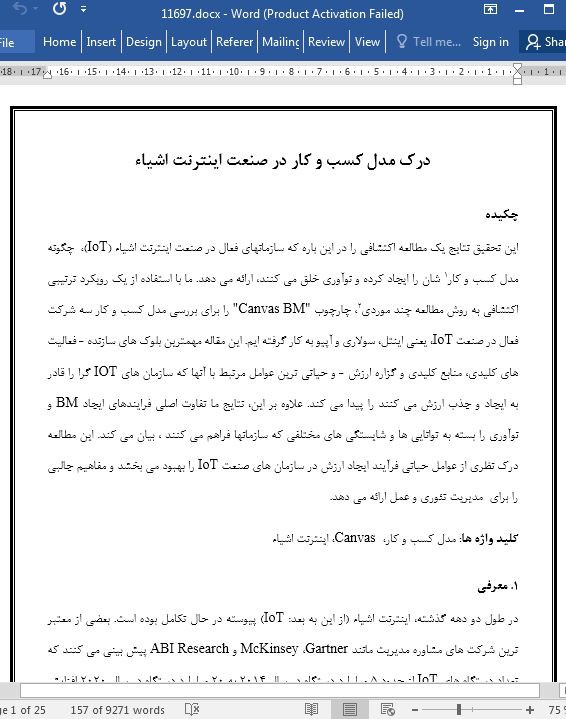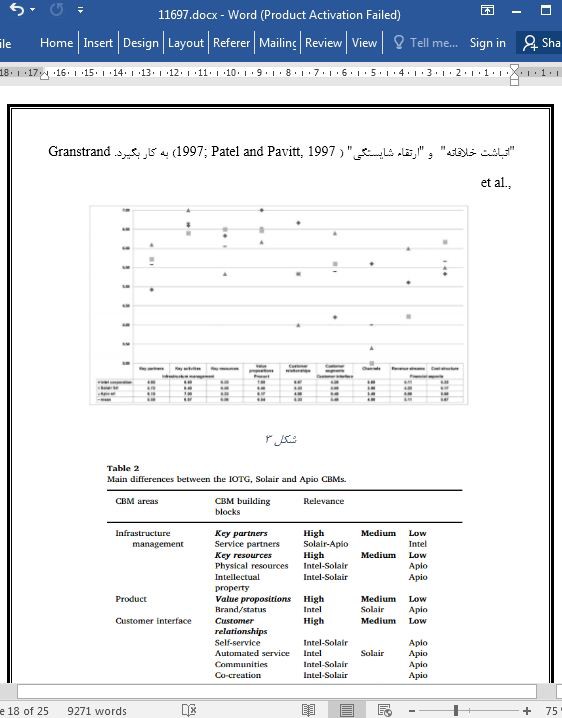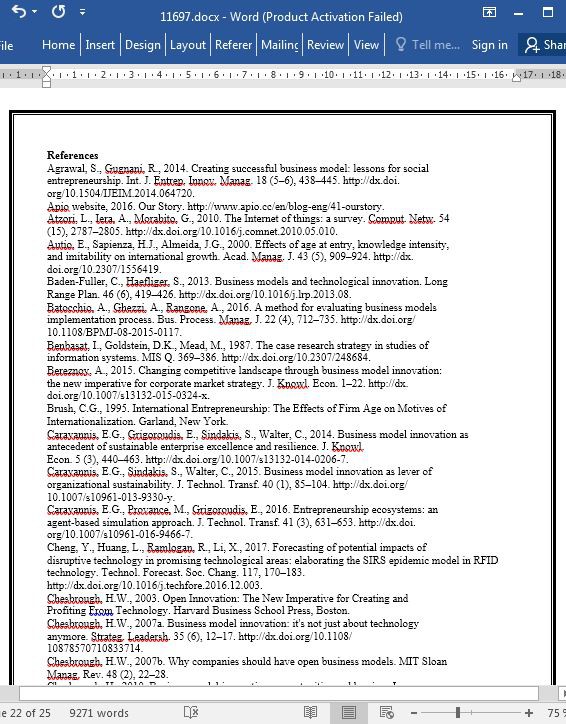
درک مدل کسب و کار در صنعت اینترنت اشیاء
چکیده
این تحقیق نتایج یک مطالعه اکتشافی را در این باره که سازمانهای فعال در صنعت اینترنت اشیاء (IoT)، چگونه مدل کسب و کار شان را ایجاد کرده و نوآوری خلق می کنند، ارائه می دهد. ما با استفاده از یک رویکرد ترتیبی اکتشافی به روش مطالعه چند موردی ، چارچوب "Canvas BM" را برای بررسی مدل کسب و کار سه شرکت فعال در صنعت IoT، یعنی اینتل، سولاری و آپیو به کار گرفته ایم. این مقاله مهمترین بلوک های سازنده - فعالیت های کلیدی، منابع کلیدی و گزاره ارزش - و حیاتی ترین عوامل مرتبط با آنها که سازمان های IOT گرا را قادر به ایجاد و جذب ارزش می کنند را پیدا می کند. علاوه بر این، نتایج ما تفاوت اصلی فرایندهای ایجاد BM و نوآوری را بسته به توانایی ها و شایستگی های مختلفی که سازمانها فراهم می کنند ، بیان می کند. این مطالعه درک نظری از عوامل حیاتی فرآیند ایجاد ارزش در سازمان های صنعت IoT را بهبود می بخشد و مفاهیم جالبی را برای مدیریت تئوری و عمل ارائه می دهد.
1. معرفی
در طول دو دهه گذشته، اینترنت اشیاء (از این به بعد: IoT) پیوسته در حال تکامل بوده است. بعضی از معتبر ترین شرکت های مشاوره مدیریت مانند Gartner، McKinsey و ABI Research پیش بینی می کنند که تعداد دستگاه های IoT از حدود 5 میلیارد دستگاه در سال 2014 به 20 میلیارد دستگاه در سال 2020 افزایش می یابد. از نظر مصرف سخت افزار، برنامه های مشتری تا سال 2020 به 1534 میلیارد دلار می رسد، در حالیکه استفاده از اشیاء مرتبط در سازمان تا سال 2020 به 1477 میلیارد دلار می رسد (Gartner، 2015). بنابراینIoT توسط شورای ملی اطلاعات ایالات متحده در فهرست شش "فن آوری مدنی انقلابگر " با تأثیرات بالقوه بر قدرت ملی ایالات متحده (NIC، 2008) گنجانده شده است.
2.4 محدودیت ها و فرصت ها برای تحقیقات آینده
این مطالعه محدودیت هایی دارد که باید مورد توجه قرار گیرد. اول، این تحقیق بر مبنای یک روش مورد مطالعه برای کاوش در BM های مبتنی بر IoT است. اگر چه روش تحقیق مطالعه موردی به ویژه برای تجزیه و تحلیل اکتشافی در ادبیات مدیریتی مفید است، اما نمی تواند ادعایی درباره رایج بودن داشته باشد، زیرا نمونه کوچک و منحصر به موضوع تحقیق بوده است. بنابراین، یافته ها در حوزه عمومی صنعت IoT و دیگر صنایع قابل تعمیم نیستند، زیرا اثبات اینکه شود یافته های این داده ها می تواند نماینده جمعیت بزرگتری باشد مشکل است. با این وجود، این یک محدودیت رایج در مطالعات کیفی مبتنی بر چنین روش تحقیقاتی است و ضعف این مقاله به شمار نمی آید. علاوه بر این، استفاده از پرسشنامه برای جمع آوری داده ها، ما را قادر به کاهش نتایج غالبا عددی که در تحقیقات کیفی معمول است کرده است.
Abstract
This research presents the results of an exploratory study of how organisations operating in the Internet of Things (IoT) industry are building and innovating their business model (BM). Using an explorative sequential approach through the multiple-case study method, we apply the “Canvas BM” framework to explore the BM of three companies operating in IoT industry, namely Intel, Solair, and Apio. The paper finds the most important building blocks - key activities, key resources, and value proposition - and most critical related factors enabling IoT-oriented organisations to create and capture value. Furthermore, our results also suggest that the main difference in the processes of BM building and innovation depend on the different capabilities and competencies possessed by organisations. This study therefore advances the theoretical understanding of the critical factors for the value creation process in the IoT industry's organisations and offers interesting implications for management theory and practice.
1. Introduction
Over the last two decades, the Internet of Things (henceforth: IoT) has been in a constant state of evolution. Some of the most prestigious management-consulting firms, such as Gartner, McKinsey analysis, and ABI Research, forecast that IoT devices would grow from about 5 billion in 2014 to as many as 20 billion devices by 2020. In terms of hardware spending, consumer applications will amount to $1534 billion by 2020, while the use of connected things in the enterprise will rise to $1477 billion in 2020 (Gartner, 2015). Therefore, IoT is included by the US National Intelligence Council in the list of six “Disruptive Civil Technologies” with potential impacts on US national power (NIC, 2008).
4.2. Limitations and opportunities for future research
This study has a number of limitations that should be addressed. Firstly, the research was based on a case study method to explore IoToriented BMs. Although the case study research method is considered particularly useful for explorative analysis in managerial literature, it can make no claim to being typical because the sample was small and idiosyncratic. Thus, the findings are not generalizable in the conventional sense to the IoT industry and to other industries, because it is difficult to establish the probability that the data findings are representative of a larger population. However, this is a common limitation of the qualitative studies based on such research technique, rather than a specific weakness of this paper. Moreover, the use of questionnaire for data collection enabled us to reduce the predominantly non-numerical outcome of data that is usual in qualitative research.
چکیده
1. معرفی
2. نوآوری در مدل کسب و کار در صنعت IoT
3. روش تحقیق
1.3 در مورد شرکت اینتل، سولاری و آپیو
2.3 تجزیه و تحلیل داده ها و نتایج
1.2.3 مدیریت زیرساخت
2.2.3 محصول
4.2.3 جنبه های مالی
4. بحث و نتیجه گیری
1.4 پژوهش و مفاهیم مدیریتی
2.4 محدودیت ها و فرصت ها برای تحقیقات آینده
منابع
Highlights
Abstract
1. Introduction
2. Business model innovation in IoT industry
3. Research method
3.1. The case of Intel Corporation, Solair and Apio
3.2. Data analysis and results
4. Discussion and conclusions
4.1. Research and managerial implications
4.2. Limitations and opportunities for future research
References
- اصل مقاله انگلیسی با فرمت ورد (word) با قابلیت ویرایش
- ترجمه فارسی مقاله با فرمت ورد (word) با قابلیت ویرایش، بدون آرم سایت ای ترجمه
- ترجمه فارسی مقاله با فرمت pdf، بدون آرم سایت ای ترجمه



